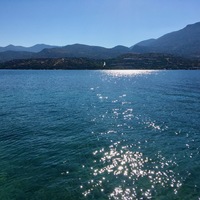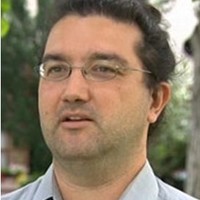Papers by Elina Kardamaki

In A.L. D'Agata, L. Girella, E. Papadopoulou and D.G. Aquini (eds.) One State, Many Worlds. Crete in the Late Minoan II-IIIA2 Early Period. Rome (SMEA NS supplement 2), 365-386., 2022
The discovery of a new Late Bronze Age palace at Ayios Vasileios in Laconia offers the opportunit... more The discovery of a new Late Bronze Age palace at Ayios Vasileios in Laconia offers the opportunity to further reassess the relationship between Crete and the Mainland in the Late Bronze Age. Recent excavations have uncovered architectural and planning elements more familiar from Crete, including a large court and wide stoas. Detailed study of pottery deposits dating to LH IIB and LH IIIA2 have integrated typological and petrographic analyses, allowing the ascription of provenance and the reconstruction of key aspects of ceramic technology. Abrupt changes in fabric and forming methods coincide with the introduction in Central Laconia of new shapes, such as conical cups, tripod cooking pots and other kitchen equipment. The study of morphology and technology suggests the interaction of local potters and communities not only with Crete but also with other Late Bronze Age centres in southern Greece, such as Kythera and Aegina. Such patterns go beyond the vague notion of "Minoan influence" and suggest that these new ceramic worlds are closely linked with activities in the monumentalised spaces at Ayios Vasileios and the Menelaion. The combination of pottery and architecture encourages us to reconstruct regional histories of mobility of pottery, technological practice, cuisine and populations groups.

Transport stirrup jars in Late Mycenaean Tiryns: Maritime Transport Containers and commodity movement in political context
Transport jars from the Mycenaean citadel of Tiryns, a coastal centre in the Bronze Age, were ana... more Transport jars from the Mycenaean citadel of Tiryns, a coastal centre in the Bronze Age, were analysed in a macroscopic and petrographic study. Over 400 vessels and vessel fragments, mostly Transport Stirrup Jars (TSJs) and Canaanite jars, were recorded; around a quarter of them were selected for analysis. The vessels derive from both the upper and lower citadel, with a few from the lower town. Their chronological span ranges from Late Helladic (LH) IIIB1 to LH IIIC Developed (ca 1300–1070 BC) but the bulk of the material dates to LH IIIB2 (ca 1200 BC), and comes from dumps derived from the final destruction of the palace. Several sources are suggested for the TSJs, some of which are inscribed with Linear B: Kythera, the eastern Aegean (perhaps Kos), Kontopigado-Alimos in Attica, Corinth and several other mainland sources, as yet unidentified. It is suggested that a large group of TSJs with shape and decoration derived from central Cretan types were produced in the vicinity of the A...
Transport jars at the Mycenaean Citadel of Tiryns, Greece: new evidence from petrographic analysis of trade in the Late Bronze Age Eastern Mediterranean
(in press) Kardamaki, E., Hachtmann, V., Vasilogamvrou, A., Karadimas, N. and Voutsaki, S. Regional diversities or occupational gap? Pottery styles during the late 14th and the 13th centuries BCE at Ayios Vasileios. In The Wider Island of Pelops.
The ongoing studies of pottery from the recently discovered palace at Ayios Vasileios in Laconia ... more The ongoing studies of pottery from the recently discovered palace at Ayios Vasileios in Laconia are focusing on establishing the chronological framework of the settlement, e.g. the dating of significant events, and last phase of occupation of the site during the Late Bronze Age. The wider comparison of the material gives us the opportunity to address once again the question of diversity and uniformity in the pottery used during the period of the climax and the last phases of the Mycenaean palatial culture using the example of two major regions of the East Peloponnese, the Argolid and Laconia.

Egypt and the Levant 30, 2020
The present paper deals with the wheel-based manufacturing technology employed for the production... more The present paper deals with the wheel-based manufacturing technology employed for the production of pottery in central Laconia and the Argolid during the Mycenaean palatial period (roughly 1450-1200 BCE). The main set of data comes from the combined macroscopic and X-Ray analyses on pottery discovered at the palace of Ayios Vasileios in Laconia. Additional material of Argive/NE Peloponnesian provenance was examined as well for comparative reasons. The latter comes from Tiryns and Tall Zirā'a, Jordan. Although growing evidence suggests that wheel-forming techniques can be more variable than one would have traditionally thought, very few studies have examined the use of the potter's wheel during the Mycenaean period and the underlying craft behaviours. Our study suggests that the knowledge of this tool in the Argolid and central Laconia was not associated with the wheel-throwing technique but the so-called wheel-coiling, and was based on similar levels of expertise. However, we can also observe variations between these two regions, especially in the ways of mastering the rotary device within the forming process. The manufacture of the wheelmade pottery in Mycenaean Greece implies thus a complex technological phenomenon that involved different potting communities participating in the social and economic organization of palatial pottery production.

Jahrbuch des Deutschen Archäologischen Instituts, 2020, vol. 135, 1-99, 2020
Maritime commodity trade from the Near East to the Mycenaean heartland: Canaanite Jars in final p... more Maritime commodity trade from the Near East to the Mycenaean heartland: Canaanite Jars in final palatial Tiryns.
Canaanite jars from the palatial site of Tiryns in mainland Greece are shown to have been producedat a number of centres on the Levantine coast, emphasising the key role of the Argive coastal citadelin trade with the eastern Mediterranean at the end of the 13th century BCE. The analytical study ofthis assemblage draws on a detailed examination of key deposits connected to the last phase of thepalace at the site and its destruction, and combines thin section petrography and chemical analysis(NAA), providing major new insights into the specific production locations of these containers alongthe Levantine coast. Based on comparative material from other Aegean sites and especially theharbour of Kommos in southern Crete, typological, epigraphic and analytical data are combined todemonstrate that, towards the end of the 13th century BCE, Tiryns was interacting with differentLevantine centres than did Kommos roughly 100 years earlier. This diachronic shift in the source ofCanaanite jars reaching the Aegean has much to tell us about changing centres of political power,the emergence of regular commodity trade and even diplomatic problems, all at a time whencontainer shipment takes off and the demand for commodities starts to dominate relations betweenthe states surrounding the seaways of the eastern Mediterranean at the end of the Late Bronze Age.
The Late Helladic IIB to IIIA2 Pottery Sequence from the Mycenaean Palace at Ayios Vasileios, Laconia doi: 10.1553/archaeologia101s73
Το Αρχαιολογικό Έργο στα Νησιά του Αιγαίου, 2017
Το Αρχαιολογικό Έργο στα Νησιά του Αιγαίου, 2017

During restoration works in 1999 by the 4th Ephorate of Prehistoric and Classical Antiquities at ... more During restoration works in 1999 by the 4th Ephorate of Prehistoric and Classical Antiquities at the west wall of the Upper Citadel in Tiryns, a dump containing large amounts of pottery and fragments of frescoes was discovered at the northernmost part of the Western Staircase terrace. The new deposit closely resembles the one with the famous Tirynthian fresco that was found about a century ago during German excavations in the same area. In the following paper I will present results from the analysis of the stratigraphy and the decorated pottery which led to the identification of three layers (Zones 1-3). Zone 2, with its rich pottery sample, marks the destruction of the palace, while the higher Zone 1 was deposited slightly later and can probably be connected with subsequent cleaning and levelling activities, necessary for the erection of the new LH IIIC megaron (Building T/the Antenbau). Thus this deposit offers unique stratigraphic evidence for the history of the Upper Citadel at the end of the 13th and the beginning of the 12th century BC.
σκεται στὴ ζωή. Ἰδιαιτέρως εὐχαριστοῦμε τὸν καθηγητὴ J. Maran γιὰ τὴ στήριξη καὶ τὸ ἐνδιαφέρον το... more σκεται στὴ ζωή. Ἰδιαιτέρως εὐχαριστοῦμε τὸν καθηγητὴ J. Maran γιὰ τὴ στήριξη καὶ τὸ ἐνδιαφέρον του κατὰ τὴ διάρκεια τῆς ἀνασκαφῆς ἀλλὰ καὶ γιὰ τὶς ὑποδείξεις καὶ τὶς γόνιμες συζητήσεις του ὅσον ἀφορᾶ τὴ μελέτη τοῦ ὑλικοῦ. Γιὰ γόνιμες συζητήσεις καὶ παρατηρήσεις ἐπὶ τοῦ ὑλικοῦ εὐχαριστοῦμε ἐπίσης καὶ τοὺς R. Jung, P. Mountjoy καὶ B. Lis. Εὐχαριστοῦμε θερμὰ τὸν Γενικὸ Γραμματέα τῆς Ἀρχαιολογικῆς Ἑταιρείας ἀκαδημαϊκὸ Β. Χ. Πετράκο ποὺ φρόντισε νὰ περιληφθεῖ τὸ ἄρθρο μας στὸν παρόντα τόμο τῆς Ἀρχαιολογικῆς Ἐφημερίδος.

Transport jars from the Mycenaean citadel of Tiryns, a coastal centre in the Bronze Age, were ana... more Transport jars from the Mycenaean citadel of Tiryns, a coastal centre in the Bronze Age, were analysed in a macroscopic and petrographic study. Over 400 vessels and vessel fragments, mostly Transport Stirrup Jars (TSJs) and Canaanite jars, were recorded; around a quarter of them were selected for analysis. The vessels derive from both the upper and lower citadel, with a few from the lower town. Their chronological span ranges from Late Helladic (LH) IIIB1 to LH IIIC Developed (ca 1300–1070 BC) but the bulk of the material dates to LH IIIB2 (ca 1200 BC), and comes from dumps derived from the final destruction of the palace. Several sources are suggested for the TSJs, some of which are inscribed with Linear B: Kythera, the eastern Aegean (perhaps Kos), Kontopigado-Alimos in Attica, Corinth and several other mainland sources, as yet unidentified. It is suggested that a large group of TSJs with shape and decoration derived from central Cretan types were produced in the vicinity of the Argive Plain. Two thirds of the TSJs, however, come from Crete. With the exception of one from the Vrokastro area of east Crete, these are evenly derived from the Chania plain and the western edge of the Mesara plain in central Crete, where the Minoan centres of Kommos, Phaistos and Ayia Triada are located.
We discuss the implications of all this for our understanding of the economy and society of Crete after the destruction of the palace of Knossos, and for the relationship between Crete and the Mycenaean palatial centres in the Argolid.
Archaeology Conferences by Elina Kardamaki
This international conference - part of the research project From Thebes to Mycenae funded by the... more This international conference - part of the research project From Thebes to Mycenae funded by the Arts and Humanities Research Council - considers production technologies of materials, artefacts and their industries in the Mycenaean World.
Books, Edited Books, and Edited Journal Sections by Elina Kardamaki
by Barbara Horejs, Christoph Schwall, Bogdana Milic, Dominik Bochatz, Katharina Rebay-Salisbury, Roman Gundacker, Felix Höflmayer, Annik Wüthrich, Bettina Bader, Natasha Ayers, Aaron de Souza, David Aston, Reinhard Jung, Teresa Bürge, Laura Burkhardt, Jasmin Huber, Elina Kardamaki, Mario Gavranovic, Benedikt Biederer, Julia Budka, and Holger Kockelmann OREA Annual Report, 2019
Research results and reports from the Institute for Oriental and European Archaeology of the Aust... more Research results and reports from the Institute for Oriental and European Archaeology of the Austrian Academy of Sciences of the year 2019 including outreach activities, excavations, surveys, analyses, material studies and current publications from all research groups and labs working in 17 countries.
by Barbara Horejs, Christoph Schwall, Katharina Rebay-Salisbury, Roderick B . Salisbury, Roman Gundacker, Felix Höflmayer, Bettina Bader, Vera Müller, Teresa Bürge, Laura Burkhardt, Reinhard Jung, Elina Kardamaki, Birgitta Eder, Mario Gavranovic, Benedikt Biederer, Michael brandl, Clare Burke, and Holger Kockelmann OREA Annual Report 2018, 2019
Research results and reports from the Institute for Oriental and European Archaeology of the Aust... more Research results and reports from the Institute for Oriental and European Archaeology of the Austrian Academy of Sciences of the year 2018 including outreach activities, excavations, surveys, analyses, material studies and current publications from all research groups and labs working in 17 countries.
In review / In press by Elina Kardamaki

Jahrbuch des Deutschen Archäologischen Instituts, 2020
Canaanite jars from the palatial site of Tiryns in mainland Greece are shown to have been produce... more Canaanite jars from the palatial site of Tiryns in mainland Greece are shown to have been produced at a number of centres on the Levantine coast, emphasising the key role of the Argive coastal citadel in trade with the eastern Mediterranean at the end of the 13th century BCE. The analytical study of this assemblage draws on a detailed examination of key deposits connected to the last phase of the palace at the site and its destruction, and combines thin section petrography and chemical analysis (NAA), providing major new insights into the specific production locations of these containers along the Levantine coast. Based on comparative material from other Aegean sites and especially the harbour of Kommos in southern Crete, typological, epigraphic and analytical data are combined to demonstrate that, towards the end of the 13th century BCE, Tiryns was interacting with different Levantine centres than did Kommos roughly 100 years earlier. This diachronic shift in the source of Canaanite jars reaching the Aegean has much to tell us about changing centres of political power, the emergence of regular commodity trade and even diplomatic problems, all at a time when container shipment takes off and the demand for commodities starts to dominate relations between the states surrounding the seaways of the eastern Mediterranean at the end of the Late Bronze Age.
Conference Presentations by Elina Kardamaki
Peter M. Day and Eleftheria Kardamaki 2023. Potting Communities during the Mycenaean Palatial Period
Paper presented to: "Social Groups and Production in Mycenaean Economies", Langford Conference, F... more Paper presented to: "Social Groups and Production in Mycenaean Economies", Langford Conference, Florida State University, 24–25 February 2023.
Paper presented at 120th Joint Annual Meeting of the Archaeological Institute of America and the ... more Paper presented at 120th Joint Annual Meeting of the Archaeological Institute of America and the Society, San Diego, January 3-6, 2019.











Uploads
Papers by Elina Kardamaki
Canaanite jars from the palatial site of Tiryns in mainland Greece are shown to have been producedat a number of centres on the Levantine coast, emphasising the key role of the Argive coastal citadelin trade with the eastern Mediterranean at the end of the 13th century BCE. The analytical study ofthis assemblage draws on a detailed examination of key deposits connected to the last phase of thepalace at the site and its destruction, and combines thin section petrography and chemical analysis(NAA), providing major new insights into the specific production locations of these containers alongthe Levantine coast. Based on comparative material from other Aegean sites and especially theharbour of Kommos in southern Crete, typological, epigraphic and analytical data are combined todemonstrate that, towards the end of the 13th century BCE, Tiryns was interacting with differentLevantine centres than did Kommos roughly 100 years earlier. This diachronic shift in the source ofCanaanite jars reaching the Aegean has much to tell us about changing centres of political power,the emergence of regular commodity trade and even diplomatic problems, all at a time whencontainer shipment takes off and the demand for commodities starts to dominate relations betweenthe states surrounding the seaways of the eastern Mediterranean at the end of the Late Bronze Age.
We discuss the implications of all this for our understanding of the economy and society of Crete after the destruction of the palace of Knossos, and for the relationship between Crete and the Mycenaean palatial centres in the Argolid.
Archaeology Conferences by Elina Kardamaki
Books, Edited Books, and Edited Journal Sections by Elina Kardamaki
In review / In press by Elina Kardamaki
Conference Presentations by Elina Kardamaki
Canaanite jars from the palatial site of Tiryns in mainland Greece are shown to have been producedat a number of centres on the Levantine coast, emphasising the key role of the Argive coastal citadelin trade with the eastern Mediterranean at the end of the 13th century BCE. The analytical study ofthis assemblage draws on a detailed examination of key deposits connected to the last phase of thepalace at the site and its destruction, and combines thin section petrography and chemical analysis(NAA), providing major new insights into the specific production locations of these containers alongthe Levantine coast. Based on comparative material from other Aegean sites and especially theharbour of Kommos in southern Crete, typological, epigraphic and analytical data are combined todemonstrate that, towards the end of the 13th century BCE, Tiryns was interacting with differentLevantine centres than did Kommos roughly 100 years earlier. This diachronic shift in the source ofCanaanite jars reaching the Aegean has much to tell us about changing centres of political power,the emergence of regular commodity trade and even diplomatic problems, all at a time whencontainer shipment takes off and the demand for commodities starts to dominate relations betweenthe states surrounding the seaways of the eastern Mediterranean at the end of the Late Bronze Age.
We discuss the implications of all this for our understanding of the economy and society of Crete after the destruction of the palace of Knossos, and for the relationship between Crete and the Mycenaean palatial centres in the Argolid.